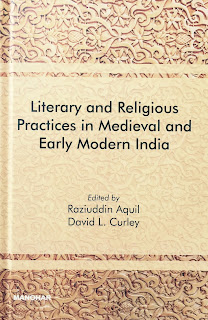Book: Short Intro - Literary and Religious Practices
Raziuddin Aquil and David L. Curley, eds, Literary and Religious Practices in Medieval and Early Modern India, first published 2016, reprint, New Delhi: Manohar, 2019. ISBN 978-93-5098-136-8. Price: Rs. 795.
The essays in this volume deal with the composition and reception of symbolic representations, and with social practices in literature and religion. In them we have many opportunities to think about writing practices and literary genres in relation to religious boundaries and identities, whether multiple, dual or exclusive. Some of the genres explored are letters, hagiographies, translations or transcreations of sacred texts, and ballads. All of them depended on an archive of other texts and memories, and all tried to maintain and reshape public memories. All of them used configurative devices—symbols and dreams, story, plot and character, parables, and affective and memorable verses, for example—to construct ideas and sentiments that defined religious identities and supported action in their defence.
We also will have many occasions to think particularly about genres of vernacular and academic history in relation to religion. Domains of religion and literature frequently overlapped in the practice of writing vernacular histories of South Asia. Vernacular genres of history perhaps can be placed on a scale that ranges from the factual to the artfully configured. However, prosaic genres of history also employ the literary devices of scene, character, and plot, together with more or less ‘factuality’, to imitate human actions and their consequences in time, while they also depend upon and reinforce an archive of public memories attached to local sites and prominent people of a shared past. Public memories were shared in oral performances as well as in written literature. Religious as well as secular purposes shaped the formation of archives of memory and the choice of vernacular genres, and secular histories as well as religious ones used literary devices to configure narratives and to shape affective responses in their audiences.
Thus, several chapters in this volume discuss writing practices in the context of religious identities and boundaries: Prannath and his followers tried to identify themselves as Muslim; the use of religious history in boundary maintenance and identity defence while encouraging Hindu disciples by a twentieth-century Indian Sufi teacher; boundary maintenance and redefinition across a wide variety of genres from hagiographies to translation and construction of a shared lexicon by Dara Shukoh; defence and criticism of Sufis and the Sufi practice of ‘playing the witness’, again in a variety of rhetorical modes: story and parable, appeals to personal experience, logical argument, and citation of religious authorities. Criticism was directed at homoerotic meditative and devotional practices.
Several chapters discuss vernacular genres with a religious dimension, and their use as sources for contemporary history: how Assamese historians used affective and configurative resources of vernacular religious genres to rewrite the bare account in chronicles of a heroic woman’s suffering, placing the story in a wider context of Indian myths, as well as in the context of the familiar sentiments of Assamese Vaishnavism; how Eastern Bengal ballads changed when they portrayed religious identities in stories about marriages across the Hindu-Muslim divide in a period of intense political competition and religious nationalism; and how an account of a Hindu disciple of a medieval Sufi saint was rewritten in a factual but religiously configured history to provide instruction for twentieth-century followers of Sufi-oriented Islam.
The contributors to the volume include Matthew Clark, David L. Curley, Mridula Jha, Scott Kugle, Sudeshna Purkayastha, Sandhya Sharma, and Mikko Viitamaki.

Comments
Post a Comment